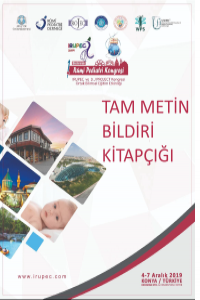Abstract
Cystic fibrosis (CF) is caused by a mutation in Cystic Fibrosis Transmembrane Regulatory Protein (CFTR) and is the most common mortal disease of white race that exhibits autosomal recessive mode of inheritance. The main disturbance is formation of abnormal secretions from exocrine glands of sweat glands, salivary glands, tracheobronchial tree, large intestine and pancreas. 85% of individuals with cystic fibrosis develop fat and protein malabsorption, which leads to steatorrhea due to pancreatic failure. This condition results in symptoms, including deficiency of fat-soluble vitamins, insufficient calorie gain, growth and developmental retardation and rectal prolapsus. Patients generally present with recurrent or persistent pulmonary infections, chronic cough, recurrent episodes of bronchitis and malnutrition.
Although incidence of cystic fibrosis in our country remains unknown, it is prevalent in our country especially due to consanguineous marriages. CF screening with Guthrie test included in context of neonatal screening program has been implemented by Ministry of Health since 1st January 2015. Thus, patients’ nutritional stuatus has improved, pulmonary functions have become better, survivals have been prolonged and quality of life has been improved.
In this study, a case of a patient who was diagnosed with cystic fibrosis due to high rate of consanguineous marriages and then diagnosed with accompanying immunodeficiency is reported.
CASE REPORT
A 30 month-old female patient had been referred to us after she was found to have two high immune reactive trypsinogen levels (1st IRT: 90 mmol/l, 2nd IRT: 70 mmol/L) by the family physician at 24 days of age. She had no complaints. On her physical examination, her vital signs were stable, growth percentiles and systemic findings were normal. Her background was nonspecific. It was learned from her family history that her parents were third-degree relatives. The sweat chloride test was resulted as 46 mEq/L (suspicious).
The patient was then begun to be followed-up in our Pediatric Pulmonology Clinic. In her follow-ups, she has administered intravenous antibiotherapy for 2-3 times annually due to recurrent episodes of bronchopneumonias. Because she had recurrent growths of Pseudomonas aeruginosa (P. aeruginosa) she was treated as inpatient and then diagnosed with chronic colonization with P. aeruginosa. The patient who had recurrent episodes of diarrhea and had been hospitalized 1-2 times a year for due to Pseudobartter Syndrome was requested cystic fibrosis gene analysis. The result of patient’s gene analysis was reported as c650 A>G heterozygous. No deletion-duplication was detected in CTFR gene. As she had a clinical presentation consistent with cystic fibrosis, she has been followed-up in our clinic with diagnosis of cystic fibrosis.
The patient was consulted to Pediatric Allergy and Immunology Clinic because of the fact that she had had more frequent hospitalizations and that the growth of P. aeruginosa in throat cultures started at a very young age. Laboratory results were as follows: White Blood Cell: 9400/ mm3, ANS : 3700/mm3, ALS: 4600/mm3 , Hb: 12.8 gr/dl and PLT: 205,000/mm3. immunoglobulin (Ig) test results were as follows: Ig G: 677 mg/dl ( 604-1941) Ig A: 23 mg/dL↓ ( 30-107 mg/dl), Ig M : 73 mg/dl ( 71-235) and Ig E: 18 mg/dl. Isohemaglutinine level 1/8, anti-HbS was 191, tetanus antibody was 2.2. In peripheral lymphocyte subgroups; total T cell ratio and natural killer cell ratio were determined to be low. The patient was then diagnosed with partial immunoglobulin A deficiency and classical natural killer cell deficiency in addition to diagnosis of cystic fibrosis. The patient was put on an intravenous immunoglobulin treatment at a dose of 400 mg/kg once in three weeks. After IVIG treatment was initiated, the patient has had no growth of Pseudomonas aeruginosa and no hospitalization (for 1 year). This case was reported as coexistence of cystic fibrosis and primary immunodeficiency is rare.
CONCLUSION
It was thought that because modified genes play a role together with a mutation in etiology of a patient with a positive mutation for cystic fibrosis and evidence of immunodeficiency, the gene related to immunodeficiency can make evidence of cystic fibrosis more prominent. Furthermore, this report is reported to highlight coexistence of two diseases in offspring of a consanguineous parent.
Keywords
References
- referans
Abstract
References
- referans
Details
| Primary Language | English |
|---|---|
| Subjects | Health Care Administration |
| Journal Section | Congress Proceedings |
| Authors | |
| Publication Date | December 10, 2019 |
| Acceptance Date | January 16, 2020 |
| Published in Issue | Year 2019 Volume: 7 Issue: Ek - IRUPEC 2019 Kongresi Tam Metin Bildirileri |


